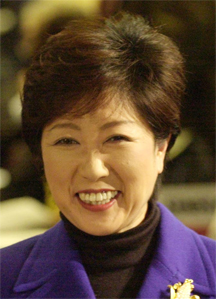Yuriko Koike, Japan’s former Minister of Defense and National Security Adviser, is a former chairwoman of Japan’s Liberal Democrat Party and currently a member of the National Diet. (The National Diet is Japan’s bicameral legislature. It is composed of a lower house, called the House of Representatives, and an upper house, called the House of Councillors.)
TOKYO – F Scott Fitzgerald famously said that “there are no second acts in American lives.” Hillary Clinton’s stunning (and, I trust, unfinished) career – from First Lady to United States Senator to presidential candidate to US Secretary of State in the administration of the man who defeated her – proves that Fitzgerald could not have been more wrong.
Today, as Clinton prepares to leave office, there is widespread speculation that she will seek to succeed President Barack Obama in 2016. She has had not only a second act, but a third as well – and millions of Americans want her to write a fourth.
Clinton’s four years as America’s top diplomat have given her iconic status around the world – and deservedly so. On her watch, two of the longest wars in US history have been wound down, America’s alliances have been reinvigorated, and young women everywhere have been encouraged to pursue their dreams – whether in academia, business, or politics. Hers is a record that ranks her among the great postwar US secretaries of state – Dean Acheson, Henry Kissinger, and James Baker.
The position of secretary of state is truly global in scope. It demands not only a coherent conception of how the world works and the place of US national interests within the international order, but also extraordinary political skill, stamina, timing, and, above all, courage. Clinton used all of these virtues to their highest possible effect.
In the midst of two wars and Asia’s rise, Clinton confronted the three great tasks that any US secretary of state must face: pinpointing the challenges at hand; developing a viable strategy that attracts the support of the entire US government and public opinion; and managing the actual practice of US diplomacy. Here, she was aided by the great confidence that Obama placed in her – a remarkable outcome, given their rivalry in the 2008 presidential campaign. Obama’s decision attests not only to his judgment, but also to her character.
Clinton’s primary challenge as secretary of state was to recast the very nature of US involvement in global affairs. The go-it-alone America of the years of the war on terror had alienated its closest allies, and had proven insufficient both to resolving the wars in Iraq and Afghanistan, and to creating a structure of peace for an Asia struggling to cope with China’s new power and assertiveness.
With Clinton at the diplomatic helm, the US once again made its alliances – in Europe, the Middle East, and Asia – both a core principle and the key operational mechanism of its foreign policy. This renewed trust in allies has been particularly important in Asia and the Middle East, where the US has used cooperation with old partners like Turkey, Japan, and South Korea, and new near-alliances with India and Indonesia, to deter aggression.
Indeed, American foreign policy’s “pivot to the Pacific” could not be undertaken without the US having first reinvigorated its relationships with Asia’s democracies. But it also could not have been undertaken without Clinton’s resolve to make China part of the solution, rather than merely a target of recrimination or containment. As a result, China is being given the opportunity to preserve its dignity while receiving incentives to integrate into a stable regional – and ultimately global – order that welcomes it as an integral player, so long as it abides by multilateral rules.
Of course, Clinton’s efforts to revitalize America’s alliances made restoring confidence in US leadership an overriding priority, which she achieved without seeking to militarize every international problem. Her approach implicitly assumed that creating conditions of cooperative strength can make the search for lasting peace self-reinforcing. Moreover, even as she emphasized the importance of alliances, she did not neglect diplomatic engagement with adversaries, though never – particularly with respect to Iran and North Korea – as simply an exercise in splitting the difference.
Clinton, the one-time legislator and practicing politician, understood that a stateswoman’s real legacy is not found in today’s headlines and opinion polls, but in lasting policies and institutions. This effort, she knew, requires a willingness to achieve one’s goals in stages, however imperfect. In her own words, “The challenge now is to practice politics as the art of making what appears to be impossible, possible.”
Finally, less noted but of real long-term consequence, Clinton made the cause of gender equality – and not only in the halls of power – a special focus of her diplomacy. Wherever she traveled, she spoke out for equal rights. “In too many instances,” she noted, “the march to globalization has also meant the marginalization of women and girls. And that must change.” Clinton has helped to bring about such change, not only for women like her (and me), but, more important, for the world’s poor, disenfranchised, and silenced women.






